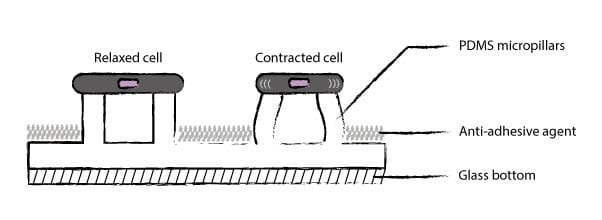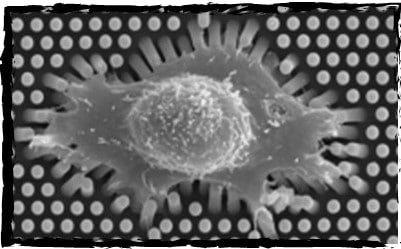TECHNOLOGY
Cells are cultured on substrates containing topographic features, micropillars, with a specific stiffness. The micropillars can either be distributed in high density to create a map of the force applied by the cell (Traction force microscopy) or their size and arrangement can be of cell size thus being useful to measure the global contractile force of a single cell.
> The deflection of PDMS pillars enables force sensing
> The stiffness of the PDMS micropillars is controlled by their size (Durotaxis)
> Several micropillars geometries and arrangements available
> Single cell force mapping (Traction Force Microscopy)
> Controllable bio-functionalization
> Available on 35 mm Petri dishes
> Compatible with high-resolution optical microscopy systems

APPLICATIONS
Force sensing, migration assays with substrate stiffness control (durotaxis), Traction Force Microscopy, etc

Fibroblast on substrate with micropillars (Léa Trichet et al. PNAS, 109 (18), 2012).
PUBLICATIONS
- Evidence of a large-scale mechanosensing mechanism for cellular adaptation to substrate stiffness
L. Tricheta et al., PNAS, 2012 109(18): 6933–6938 - Toward Physiological Conditions for Cell Analyses: Forces of Heart Muscle Cells Suspended Between Elastic Micropillars
A. Kajzar et al., Biophysical Journal, 2008 94: 1854–1866 - Mechanical regulation of cell function with geometrically modulated elastomeric substrates
J. Fu et al., Nature Methods, 2010 7(9): 733–738 - Probing Cellular Traction Forces by Micropillar Arrays:Contribution of Substrate Warping to Pillar Deflection
I. Schoen et al., Biophysical Journal, 2008 94 1854–1866 Nano Letters, 2010 10(5): 1823–1830
- For whom the cells pull: hydrogel and micropost devices for measuring traction forces
A. Ribeiro et al., Methods, 2016 94: 51–64 - Micropost arrays for measuring stem cell-derived cardiomyocyte contractility
K. Beussman et al., Methods, 2016 94: 43–51

